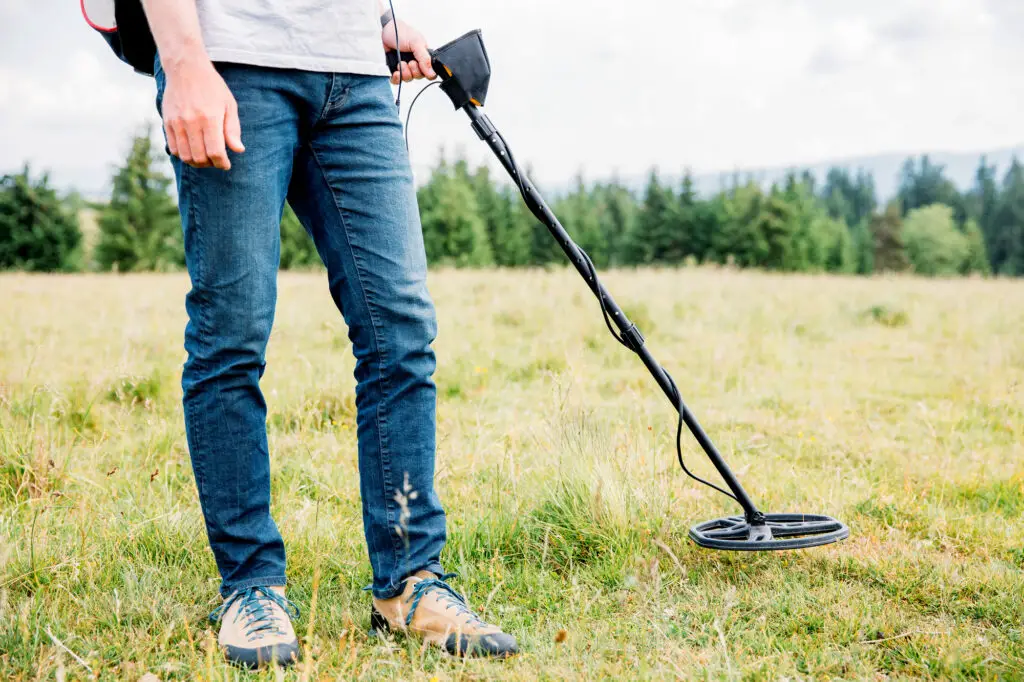Imagine a beautiful day in the park – children are laughing, the sun is shining, and the air is filled with the sweet scent of freshly cut grass. Suddenly, the laughter gives way to tears as a precious piece of gold jewellery, perhaps a cherished heirloom or a treasured engagement ring, slips from a finger or chain and vanishes into the verdant carpet beneath your feet.
While it may seem like an impossible task, retrieving your lost golden keepsake from the unforgiving clutches of the lawn is far from being a lost cause. Rest assured, gold lost is not gold gone! With a keen eye, a strategic approach, and the right tools, you can turn the tables on such misadventures and locate your missing jewellery in no time.
In this blog post, we will embark on a journey of discovery – not just of your lost treasures hidden in the grass, but also a comprehensive understanding of why these objects are so easily lost, the factors that can complicate the recovery process, and the tried-and-tested methods to uncover them successfully. We’ll offer a guide for everyone – from the panicked party-goer who has just lost a sentimental piece of gold jewellery, to the aspiring treasure hunter looking to dip their toes into the fascinating world of metal detecting.
So, take a deep breath, hold onto your hats, and let’s dive into the intriguing world of finding lost gold in grass. Prepare to become a master in locating that elusive glimmer amongst the green!

Why Is Gold Jewellery Easily Lost In Grass?
Gold jewellery is easily lost in grass for a few reasons. The physical properties of the jewellery, the nature of grass, and certain human factors all contribute to the phenomenon.
Size and Shape of Jewellery: Gold jewellery pieces are often small and delicate, with complex shapes. Rings, earrings, and thin necklace chains can easily slip off without the wearer noticing. Their small size makes them hard to spot, especially when they land in grass.
Color Camouflage: The bright, reflective quality of gold can often work against it when it lands on a grassy surface. Sunlight reflecting off the grass can camouflage the shine of gold. Additionally, grass, especially if it’s thick and healthy, tends to have a shadowy undertone due to the layers of blades blocking sunlight. This can further reduce the visibility of a shiny object at the base.
Grass Structure: Grass, by its very nature, is a thick, layered, and complex surface. When a piece of gold jewellery falls into grass, it can easily slide between blades and descend to the soil level, effectively disappearing from sight. The grass blades act like a net, trapping the fallen object within.
Human Factors: Accidental losses often happen during outdoor activities like picnicking, playing sports, or even gardening, where the individual’s focus is not on their jewellery. Movements, gestures, or impact can cause jewellery to become loose and fall. And since people may not realize the loss immediately, tracking the exact location becomes more challenging.
Weather and Environmental Factors: Weather conditions like wind and rain can further complicate the situation. They can move lightweight pieces or push them deeper into the grass, making them harder to locate.
Understanding these factors is the first step towards devising effective strategies for locating and retrieving lost gold jewellery in grass.
Ways To Find Lost Gold Jewellery In Grass
Flashlight
Finding gold jewellery in the dark might sound challenging, but it can be done with the right technique and a good flashlight. Here’s how:
Choosing the Right Flashlight: A high-lumen flashlight with a narrow beam is ideal for this purpose. High lumens ensure the flashlight is bright enough, and the narrow beam will help you focus on small areas at a time, making it easier to spot a tiny piece of jewellery.
Methodical Searching: Start from a place where you think the item might have fallen, and slowly work your way outward in a spiral or grid pattern. This systematic approach ensures that you cover all potential areas.
Angle Matters: Shine the flashlight so that the beam skims the surface of the grass at an oblique angle rather than straight down. This will cause any metallic object to reflect light and potentially sparkle, making it easier to spot.
Look for Glinting: Gold jewellery will reflect light and should give off a distinct glint. Be patient and watch for this glint as you move your light across the grass.
Getting Down Low: You might need to get down on your hands and knees to get closer to the grass. This not only improves your ability to spot the jewellery but can also allow you to feel around with your hands.
Take Your Time: Rushing won’t help. Take your time and move slowly. If you’re scanning too fast, you might miss the piece even if your light reflects off it.
Remember, while a flashlight can help in finding your lost jewellery, it can still be a tedious process depending on the size of the search area and the size of the lost item. The flashlight method is most effective when you have a relatively good idea of where the item might have fallen. It can be more challenging when searching large, undefined areas.
Push The Grass Down
Indeed, manually manipulating the grass can be an effective way to locate lost gold jewellery. This method is based on changing the orientation and position of the grass blades to reveal hidden objects and make them easier to spot. Here’s how you can do it:
Begin at a Likely Spot: Start where you think the jewellery might have fallen or where you were when you last saw it.
Use a Flat Object: Use a flat, broad object like a piece of cardboard, a small board, or even your hand. This is to push the grass down gently without harming it or causing damage to your lost item.
Pushing the Grass Down: Carefully and methodically push the grass blades down in sections, working in a pattern that ensures you don’t miss any spots. This could be in lines, spirals, or a grid – whatever makes sense based on the layout of the area.
Watch for Changes: As you flatten the grass, you’re changing the way the light hits and reflects off anything that might be hiding there. Keep an eye out for any glint or change in color that might indicate the presence of your jewellery.
Check Multiple Angles: Once you’ve pushed down a section of grass, check the area from multiple angles. Depending on the shape and design of your jewellery, it might catch the light more easily from one angle than another.
Comb Through: Once you’ve pushed the grass down, you might also want to gently comb through the grass blades with your fingers. Be gentle so you don’t risk pushing your item further down.
By pushing the grass down, you’re essentially reducing the amount of cover the blades provide, exposing the ground underneath and potentially revealing your lost gold jewellery. It’s a simple method, but it can be quite effective, especially for smaller areas. However, it’s crucial to approach this task with patience and care to increase your chances of success.
Magnets
While the idea of using magnets to find lost jewellery might sound practical, it’s important to note that pure gold is not magnetic. Therefore, a magnet won’t attract a piece of jewellery made of pure gold. However, if the gold jewellery is mixed with other magnetic metals, or if the piece contains magnetic parts (like the fastenings, clasps, or certain gem settings), a strong magnet could be of help. Here is how you can use a magnet to aid in your search:
Choose a Strong Magnet: Opt for a high-strength magnet, often referred to as a neodymium magnet. These magnets are compact but have a very high magnetic pull, which could be helpful in this scenario.
Safe Handling of the Magnet: Always be careful while handling strong magnets. They can snap together forcefully if brought too close to each other or to a metallic object, which can cause injury.
Methodical Searching: Similar to other searching methods, start from the place where you think the jewellery might have fallen and slowly work your way outward in a spiral or grid pattern.
Sweeping the Grass: Hold the magnet just above the grass and sweep it slowly across, ensuring you’re covering all areas. Pay close attention to any pulling sensation. Remember to protect your magnet from direct contact with the ground to prevent it from attracting soil particles or small metallic debris.
Checking the Magnet: Frequently check the magnet for any small pieces of metal. Remember that it might pick up other metallic debris, so you need to inspect carefully.
Remember that while this method could be effective if your jewellery has magnetic parts, it won’t work for pieces made purely of gold. Therefore, it’s best used in conjunction with other searching methods. If you’re unable to find your lost jewellery despite trying these methods, consider hiring a professional metal detector service, as they have specialized equipment and expertise to increase the chances of retrieval.
Garden Rake
Utilizing a rake can be an effective method for finding lost gold jewellery in grass, especially for larger items like bracelets or necklaces. The process involves gently manipulating the grass and soil, hoping to catch the lost item in the rake’s tines. Here’s how to do it:
Choose the Right Rake: Opt for a plastic rake, if possible. A metal rake can potentially damage your jewellery, especially if the item is delicate. A leaf rake with flexible, widely spaced tines can gently comb through the grass without harming the jewellery or the lawn.
Gentle Raking: Start at the area where you think you lost the jewellery. Gently rake the grass, covering the area systematically. Be careful not to rake too aggressively as you could unintentionally fling your jewellery outside the search area or damage it.
Look and Listen: As you rake, keep an eye and ear out for anything unusual. The jewellery may reflect light differently than the grass, or it may make a sound when caught or brushed by the rake.
Check the Rake Frequently: Periodically, stop and check the tines of your rake. The lost item might get caught in them.
Use Other Methods in Conjunction: Raking can be a first step in a broader search strategy. Once you’ve raked the area, you might want to follow up by manually checking the grass or using a flashlight or metal detector if you have one.
It’s worth noting that while raking can be useful, it might not be as effective for smaller items like earrings or thin rings, which could easily fall through the rake’s tines or be buried further into the soil. Always remember to be gentle and patient to protect your precious jewellery from potential damage.
Metal Detector
A metal detector is one of the most effective tools you can use to locate lost jewellery in grass. This device detects the presence of metal beneath the surface by generating an electromagnetic field. When this field interacts with a metallic object (like your lost gold jewellery), it causes a change in the field, which the detector senses and alerts the user. Here’s a step-by-step guide to using a metal detector to find your lost jewellery:
Choose the Right Metal Detector: Not all metal detectors are the same. Some are designed to find specific types of metal. If you’re looking for gold, make sure you have a detector that’s tuned to locate gold specifically. Some advanced models even have a “jewellery mode” that’s designed to find jewellery items.
Understand Your Detector: Spend some time getting to know your metal detector and how it works. Read the user manual and understand what the different signals and sounds mean. Practice with it, using items similar to the one you’ve lost, so you know what signal to listen for.
Sweep Slowly: Turn on the metal detector and start sweeping it slowly over the area where you lost the item. The detector should be close to the grass, but not touching it. Move in a methodical pattern to make sure you cover the entire area.
Listen for the Signal: Most detectors will make a noise or vibrate when they detect metal. Pay close attention to these signals. When you get a hit, mark the spot and continue sweeping the area to ensure there are no other signals nearby.
Inspect the Spot: Once you’ve marked a promising spot, carefully inspect the area. You might need to part the grass or gently brush away soil to find your item. A handheld pinpointer metal detector can be particularly helpful in pinpointing the exact location once you’ve narrowed down the area with your larger detector.
Be Patient: It can take time to find a lost item with a metal detector, especially if the area is large or if there’s a lot of metal debris. Be patient and persistent.
Remember, using a metal detector requires practice and patience. But with careful and methodical searching, it can be an incredibly useful tool to locate lost gold jewellery in grass. If you don’t own a metal detector, consider hiring a professional metal detecting service, or check if you can rent a metal detector from a local tool rental service.

